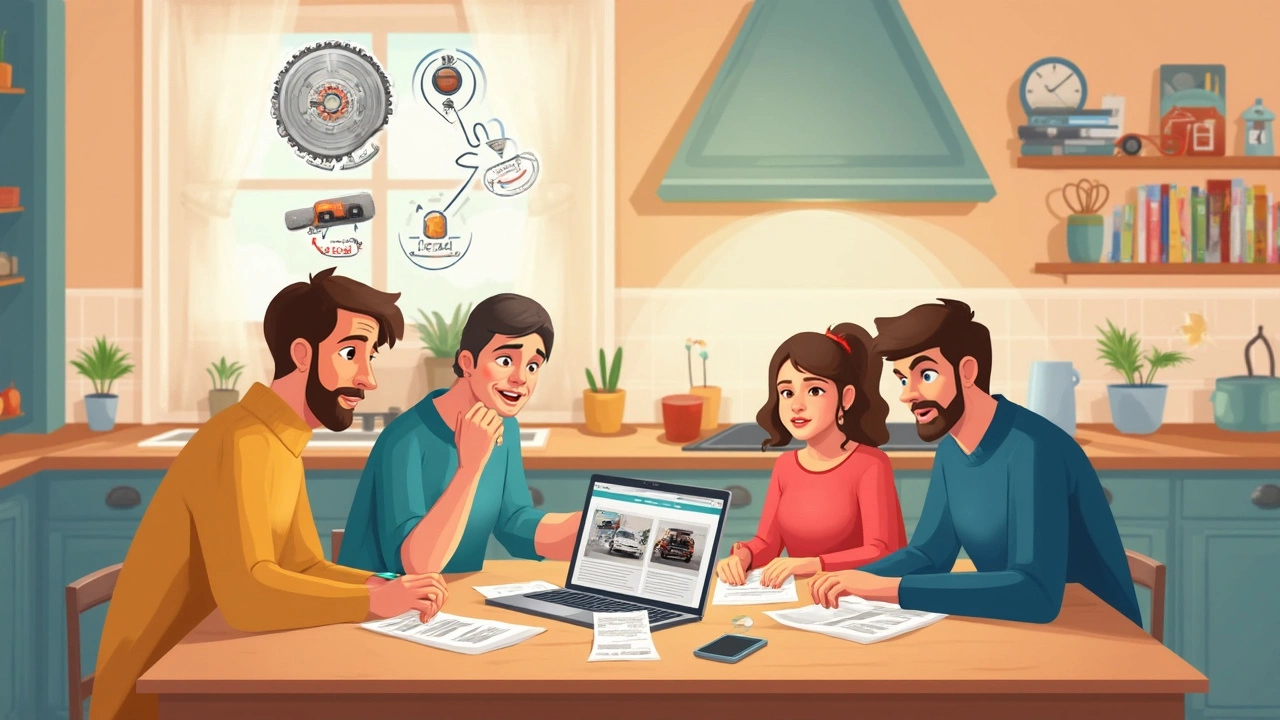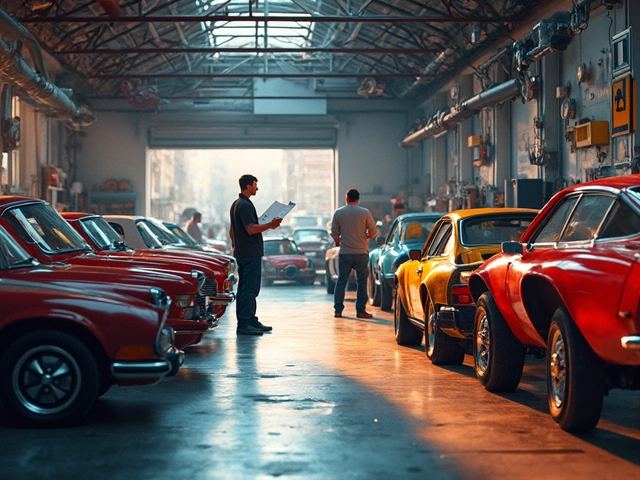Ever looked up how much a clutch kit costs and left more confused than before? Yeah, you’re not alone. The price can swing wildly—sometimes as cheap as a nice dinner out, sometimes more than your TV. But why?
Let’s cut through the confusion. The price tag depends mostly on your car model, where you buy the kit, and whether you’re paying a mechanic to throw it in. Older compact cars? Kits can be pretty affordable. Fancy European models or trucks? Get ready for sticker shock.
Here’s where it gets tricky: the cost isn’t just about the parts. Labor often costs more than the kit itself. Shops need to drop the transmission, which is no quick job. Shops in big cities or at dealerships usually upcharge even more.
- What Affects Clutch Kit Prices?
- Real-World Price Ranges
- Labor Costs: An Unpleasant Surprise
- Tips to Get the Best Deal
What Affects Clutch Kit Prices?
If you've ever wondered why one clutch kit cost twice as much as another, here’s the deal: it all comes down to a mix of parts, your car type, and where you’re shopping. Not every clutch kit fits every car, and some are just built tougher than others—so you pay for that.
First, your car make and model play a big part. Something common like a Honda Civic clutch kit? It’ll usually be way cheaper than a kit for a BMW or a full-size truck. Parts for foreign or luxury brands nearly always cost more, sometimes double or even triple what you’d pay for a mainstream model.
Second, not all clutch kits are made the same. Kits for small sedans are pretty basic, but if you have a heavy-duty pickup or a performance car, you’ll be looking at stronger materials, upgraded pressure plates, and sometimes extra parts. Those upgrades bump up the price.
Where you buy matters, too. Big chain auto parts stores sometimes charge more than online retailers. But online deals can be a gamble—no easy returns and questionable quality unless you stick with trusted brands. Always double-check what each kit includes; some come with the flywheel or slave cylinder, while others don’t.
- OEM vs. Aftermarket: Original equipment manufacturer (OEM) kits cost more but usually fit perfectly. Aftermarket kits vary in quality and price. You can sometimes save big going aftermarket, just keep an eye on reviews.
- Local availability: If your kit is rare or needs to be shipped, expect higher prices or longer wait times.
- Extra required components: Sometimes you’ll need a new flywheel, throwout bearing, or slave cylinder—adding to the final tally fast.
Most drivers don’t realize that the biggest price jumps come from these little differences. Spend some time comparing, and you can avoid overpaying for the same outcome.
Real-World Price Ranges
So, what will you actually pay for a clutch kit? The answer: it depends—big time. Most people see a clutch kit cost anywhere from $150 to $850 just for the parts. Compact cars like the Honda Civic or Toyota Corolla usually land at the cheaper end, around $200 to $300 for a basic kit, sometimes even less if you catch a sale online. Trucks and sports cars—think Ford F-150 or Subaru WRX—can push well over $500, and if you drive a high-end European or luxury car, you could be looking at $800 or more for just the kit.
What does a kit actually include? Typically, you get the clutch disc, pressure plate, and a release bearing. Some also toss in a pilot bearing or an alignment tool (handy if you or your mechanic are doing the work). Double-check, though, because not all kits are created equal, and skipping a small part can mean another trip to the shop.
Brands matter for price, too. Well-known names like Exedy and LUK generally cost more than no-name parts on eBay, but you’re paying for tested reliability. Most mechanics won’t install a kit they don’t trust, so it’s usually worth the extra few bucks to avoid issues later on.
Want to save more? Check out local parts stores. Sometimes they run promotions or price match online deals. Just make sure you’re buying the right fit for your car’s year, make, and model—no one wants to get halfway through the job and realize the parts don’t match.

Labor Costs: An Unpleasant Surprise
If you’ve ever gotten a quote for a new clutch, you probably did a double-take at the labor bill. Most people think the money goes into the parts, but in reality, labor is often the priciest part of the job. Why? Because replacing a clutch means taking out the transmission, which usually takes around 4 to 8 hours, sometimes even longer for tight engine bays or all-wheel-drive setups.
Shops don’t charge pennies for this kind of work. According to RepairPal and AAA, most mechanics charge anywhere from $70 to $160 per hour, depending on your location and the shop’s reputation. Remember, those hours add up fast.
| Vehicle Type | Average Labor Hours | Total Labor Cost Estimate |
|---|---|---|
| Small sedan (e.g. Honda Civic) | 4-6 | $350 - $950 |
| Pickup truck (e.g. Ford F-150) | 6-8 | $500 - $1,250 |
| European car (e.g. BMW 3 Series) | 7-10 | $750 - $1,600 |
Let’s be real—dealerships tend to sit at the higher end. Independent mechanics are usually more affordable, but make sure they know clutches. Labor costs also spike if the shop finds anything else worn out, like the flywheel. Don’t be shocked if they call with “extra” stuff they recommend replacing while they’re in there.
- Pro tip: Ask for a breakdown of hours in your quote. If labor looks inflated, don’t be shy—get a second opinion before handing over your keys.
- Some DIY folks save big on labor by doing it themselves, but unless you have a good set of tools and time (plus patience), it’s one of the trickiest jobs out there.
When budgeting for a full clutch kit cost, don’t forget labor is the heavy hitter—sometimes double what you’ll spend on parts alone.
Tips to Get the Best Deal
If you want to pay less when it’s time to replace your clutch, there are real ways to save. It’s not all about picking the cheapest mechanic and hoping for the best. There’s a smart way to get value without risking your ride.
- Clutch kit cost varies a lot between auto part stores and even more online. Check prices at big chains like AutoZone, NAPA, and O’Reilly, but also look at online sellers such as RockAuto and even Amazon. It’s common to spot the exact same kit for up to $150 less just by shopping around.
- Ask mechanics if you can bring your own parts. Lots of independent shops are cool with this, and it gives you more control over what’s actually going into your car. Sometimes you’ll avoid their parts markup too.
- Compare labor quotes. Use sites like RepairPal for rough estimates, but always call at least three shops in your area for real quotes. Dealers usually cost more. Local shops can be hundreds cheaper for the same job, especially for older vehicles.
- Double-check if you really need a full kit. For some cars, just replacing the clutch disc and resurface the flywheel can save money, but don’t skip the throw-out bearing if it’s worn—it’ll bite you later.
- Look for hidden deals. AAA discounts, local coupons on shop websites, or “all-in-one” packages pop up a lot, especially in slower seasons. Don’t be shy—ask up front if the shop offers any specials or price matching.
- Timing helps. If possible, plan repairs during the off-season—typically late winter—when shops run deals to bring in business during slow months.
The biggest mistake? Rushing the job out of panic. If you catch clutch problems early (slipping, odd noises), you have time to shop around and pick when and where to fix it. Jumping at the first quote can cost you hundreds more.






